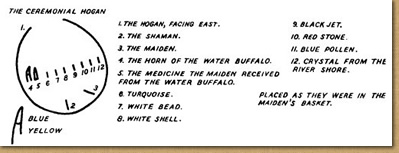
STORY OF THE RAIN CEREMONY AND ITS HOGAN
From the Navaho, The Wanderings
"The main poles of this ceremonial hogan should be raised with a chant," said the Water Buffalo.
You should pour the water on the poles from the top to the bottom. The water used must come from the sacred springs of the East. This water must be gotten and carried in a water jar. Then the mud from the bottom of the water should be rubbed on the poles from the top down. You must use all growing things, beautiful flowers and all the plants, to finish the hogan. Then only your descendants who know the chants and prayers and have the medicine will enter the hogan. Only they will be able to perform this ceremony. One will be the priest. The mud taken from the sacred water will be rubbed on his body, arms, chest, and back. He must then sit down and make four sounds like a frog. The mud from the sacred water is called tlah la'haddan, gotten from under the water.
He continued to tell them of the preparations for the ceremony. First must enter a young man, bringing in food for the shaman. The food must be made from the plant called quotse, a kind of cactus. After the young man comes into the hogan and places the food before the shaman, those present will say: "Here comes the Black Cloud. Now we have the Male Rain." Next a maiden with a basket of food for the priest enters the hogan. This food is made from the seeds of the plant called tlo de'i, marsh elder. When she puts the basket down the others will say: "Here comes the Black Vapor. Now we have the Female Rain."
Those who wish to attend the ceremony will then enter the hogan, bringing with them the mixed chips of stone as offerings. A curtain will hang in the doorway. The man entering will push it from left to right with his right hand. The hogan faces the East, and when he enters he circles the hogan as the sun travels. A small buckskin having been spread on the ground, the man places his offering of stones upon it, saying: "I come from the Big Water. I come with the Male Rain. I come with the White Corn." His gift must be turquoise.
note: The medicine for this ceremony was kept sacred. It was buried at the foot of the Lukachuki Mountains at the time of the Navaho uprising. It rains often there now.
Then a woman opens the curtain from right to left, and she circles the fire as the sun travels. She must hold her stones, white beads, over the buckskin and say: "I come from the Big Water. I come with the Black Vapor. I come with the Female Rain. I come with all the beautiful flowers." She must then place her stone offering on the buckskin and go to the north side of the hogan and sit down. The men sit on the south side. After this their children and friends place their stone offerings and sit in the hogan. The stones should be crystal, jet, red stone, or shells. The father or mother must bring those, one for each member of the family.

The Ceremonial Hogan
There must be no relationship between the shaman and the maiden. They represent the male and the female rain.
The people sit on opposite sides, next to the wall. They chant all during the night until dawn.
Then the man and the maiden both bathe and wash their hair. The man dries himself with white cornmeal, and the maiden uses the yellow cornmeal. Their hair hangs loosely down the back. The maiden should wear a garment of white cotton cloth. The man has buckskin thrown over his shoulders. They leave the hogan and start out chanting. They go either to the top of the Sacred Mountain, Chol'i'i, or to the Place where the Rivers Come Together, or to some sacred spring. The maiden should be a descendant of those Four (the two fetishes and the white and yellow corn). There are very few left. Or she could be of the Beautiful Goods People. The man should be of the clan Tqo yah ha'tline, a descendant of the Maiden.
After they reach whichever holy place is decided upon and make their offering of medicine and the gift of stones, they sit side by side and pray. Should they see flowers, water, clouds, or corn all is well. If they see blood it will be a bad sign.
Then they return and they tell what they have seen.
This is the story of how the Maiden got the medicine, and it is how the clan called Tqo yah ha'tline uses it to bring rain.